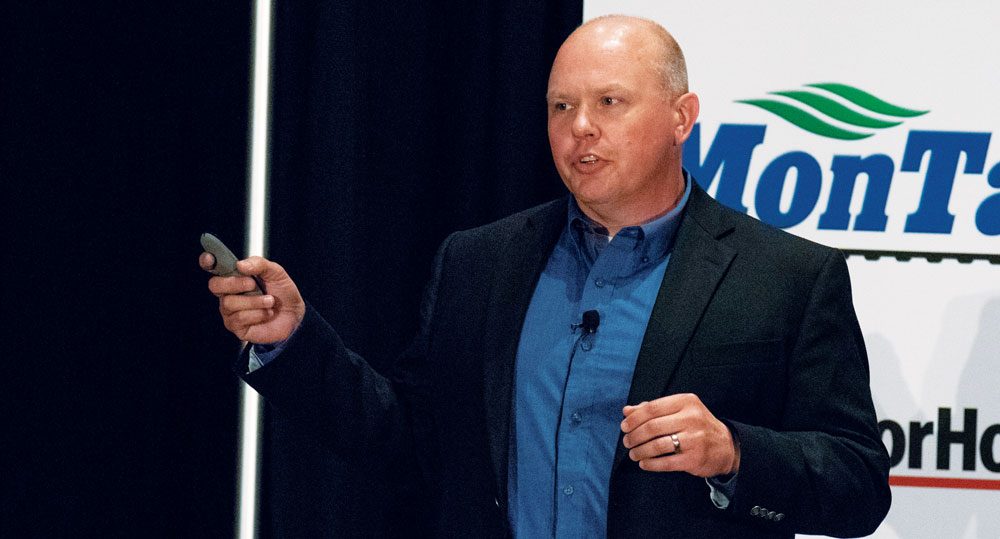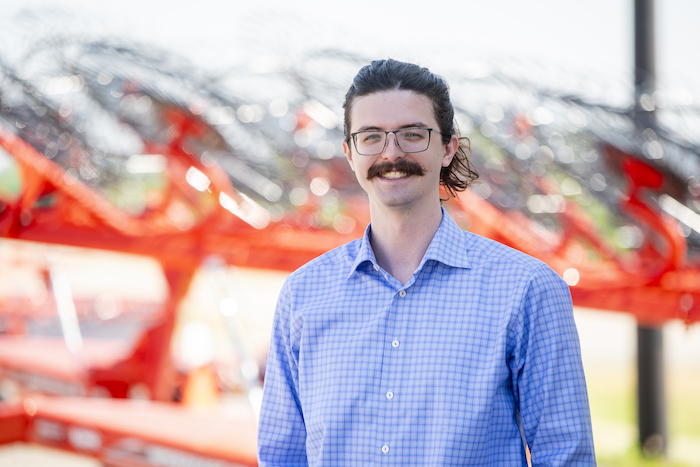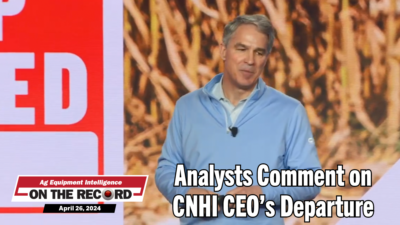In April 2021, 4-store AGCO dealer Livingston Machinery and 5-store applicator dealer Ag Solutions Group received investment from private equity firm Ag Solutions Group Holding Co. Specifically, Midwest Growth Partners partnered with co-investors Summit Equity Group, Northcreek Mezzanine and company management to capitalize Ag Solutions Group Holding Co. for the acquisitions.
As covered in the Ag Equipment Intelligence 2021 Big Dealer Report, private equity funds acquiring stakes in farm equipment dealerships has been a growing trend as of late. This year’s Big Dealer report lists 10 big dealers who have received investment from private firms.
Livingston Machinery President and CEO Shawn Skaggs sat down with Farm Equipment to discuss the timeline Livingston Machinery went through to achieve the partnership, including what hurdles they encountered, what benefits the dealership will see with the additional capital and what he thinks other dealers need to know about seeking private equity investments.
Farm Equipment: Can you start by giving us a quick breakdown of the timeline on how Livingston Machinery started their ESOP (employee stock ownership plan), and why you ended up moving away from that model?
Shawn Skaggs: We were an ESOP for 11 years before we started considering whether or not we should bring different partners into the business and maybe look at a different business structure. There were a lot of factors that led up to that conclusion.
Livingston Machinery Key Facts
- Began ESOP in 2009
- Worked with brokerage ClearRidge Capital to find private equity investment
- Received investment and ended ESOP in April 2021
- Investment came from Midwest Growth Partners, Summit Equity Group and Northcreek Mezzanine
- Investment led to quick lease on a 5th location
A lot of it came from the fact that like many dealers, we struggled back in 2015 and 2016, when everybody went through the ag downturn. With us being an ESOP, we had to manage what’s called our repurchase liability, which means that whenever somebody leaves the company or they retire, we have to repurchase the value of shares back from them. An ESOP, in general, is geared toward creating retirement for people, and you’ve got to pay for that retirement. When we went through the downturn in 2015 and 2016 and we had to let a lot of people go, it actually created a bubble in our repurchase liability.
Five years down the road from 2015-16 is when that bubble would have come to fruition. So 2021 is whenever that bubble would have really started, and it would have lasted over a 5-year period where we’d have a really high cash demand for our repurchase liability.
At the same time, we were faced with what we felt was a lot of growth opportunity in our market. We didn’t feel comfortable going out and going after that growth with that repurchase liability hanging over our head because growth takes a lot of cash. So we started looking at some different options or other partners that we could bring in that would still allow us to run the business the way we’ve always run it but also give us the capital that we needed to grow. That’s a lot to ask, and it takes a very particular fit to do that. When we started thinking about that and talking about it with our board of directors, the board decided that we should engage a brokerage to talk to some prospective buyers and see if there happened to be a fit.
We ended up putting together a packet on the business that didn’t disclose who we were. We did a lot of due diligence upfront and then the brokerage shopped us to prospective buyers in the market.
They made contact with 362 different private investment firms just to see if they were interested. And of those, there were 74 that were interested enough to sign a confidentiality agreement to get more information.
From those 74, we narrowed it down to some that we felt might be a good fit. We scheduled some interviews so we could talk face-to-face about the possibilities. We were able to use that process to come up with partners that were an ideal fit.
They offered a very fair price that was a big boon to our ESOP participants, and we felt it was a perfect fit. The partners that we found have ag backgrounds, have owned dealerships for over 15 years and were geared toward ag investments. They were willing to let us run with our growth plans and just support us in those efforts.
It really couldn’t be much better. It was a long process to get through the transaction. You have to satisfy all the attorneys and all the banks, and it takes a lot to do that. But we knew we’d found the right partners, and the ESOP participants were really excited about the opportunity.
FE: For anyone who might be confused about what an ESOP is, can you give a quick rundown of how it works?
Skaggs: An ESOP is an employee stock option plan, and the way it works is just like any other qualified retirement plan. The business is owned by a qualified retirement plan, but where most of the confusion takes place is in how the business is going to be run. It’s run just like any publicly traded company. It’s run with a board of directors that makes decisions and an executive team that makes the day-to-day decisions. It’s not like every employee gets a vote on every single thing that you do.
Dealer Takeaways
- Use third-party firms to ease transition into or out of ESOP
- Potential investors will be interested in your EBITDA
- Find investors that will stay out of your day-to-day, have an ag background
The other thing that people sometimes get confused about is that your employees don’t actually own any of the shares. What happens is the ESOP trust, which is where that retirement plan is contained, owns 100% of the shares. Then the participants get a value of shares assigned to them. They get those allocations on an annual basis after an annual valuation by a third-party firm that places a value on your company based on several factors and methods. Then they take that value and divide it out by the number of shares. Those shares get allocated out to participants as the debt gets paid off to pay for the company. So if we paid off, let’s say $150,000 worth of debt this year, then $150,000 of that share value gets allocated out to participants.
FE: What benefits did Livingston Machinery see in beginning the ESOP back in 2009?
Skaggs: The reason we ended up going with an ESOP was actually because the current owner at that time, Earl Livingston, had a little bit of a health scare. He was really worried that if something did happen to him, if the business had to get passed down, they might not be able to pay the taxes without selling the business. He was worried about estate planning, succession planning and wanted to make sure that his employees and his customers would always be taken care of. To him, the ESOP seemed like a good way to do that and a great way to reward all the people who had helped him build his business.
It was a good option for him, because it allowed him to sell the business and take that and set it aside for his family but still be involved in the business and run it day-to-day.
FE: How would you say your staff reacted when you first implemented the ESOP?
Skaggs: It was a mix of reactions. Some people were excited about it, and there was a lot of confusion about what it is and how it works.
Thankfully, we had some really good third-party advisors that helped us through that transaction. They were able to come in, and we had meetings at each of the stores to let the employees know what an ESOP is and how it works.
FE: You mentioned forming a packet when the brokerage shopped around for investors, how was that assembled?
Skaggs: They put together as much of the due diligence buyers would want to see beforehand, before you actually even get to a point where you’re talking to someone who might be a potential buyer. There’s actually a lot of work that goes into that.
Whoever is helping to put together that packet is going to need probably 70-80 hours to get together the information they need. The brokerage wanted a packet they could lay in front of potential buyers and have everything that they’re going to want to know right there.
It’s going to have all of your financial details, every vendor that you’ve got, your largest customers, any fluctuations in the business. They put together several reports to show not just your financials, but how your financials have fluctuated over the years and seasonally.
FE: What were some of the notable changes to Livingston Machinery’s business model once you had outside investors?
Skaggs: Outside of getting a CFO, which we hadn’t had before, we’ve had to change some of our plans on the financial side, because as an ESOP, one of the big advantages we had was we didn’t pay federal income tax. So we really didn’t even think about the tax side of it. We were just focused on net profit. And so now we’ve got to put a lot more thought into tax liability. But other than that, there’s really no changes to the day-to-day operations, other than our investors helping us to find new growth opportunities.
“The most important thing is to make sure you find the right match in an investor…”
We’ll actually be opening a new store in Lubbock, Texas, in the first part of July. So right off the bat, we’re going to add a new location down there, and we’re looking for more opportunities like dealerships to acquire or open territories to fill.
We might’ve been able to do this new location without the private equity but honestly, because we had that repurchase liability hanging out there, I don’t know if we would have been brave enough to jump out on that limb.
FE: How often do you communicate with your investors, and how are they involved with the business?
Skaggs: Our board of directors is composed of members of Midwest Growth Partners, Summit Equity, North Creek Mezzanine and myself, and that’s who will be determining the long-term strategy. They’ve designated one person, John Flaugh with Summit Equity, as the point person on the deal for the investors. John started out as a CFO at a Spra-Coup dealership before he went into private equity. I communicate with John several times a week, just talking about how things are going in the business and any new opportunities we’ve spotted. But as far as their involvement in the day-to-day, they have done a great job of letting us go out and run our business. That’s the great thing about it: we already had a profitable, successful business, we just needed more capital to grow.
But there’s also opportunities we’re capitalizing on with all the other different companies that they’ve invested in, or that they own, where they’re going to have some advantages that we can use. That could be in knowledge and processes or in terms of being able to combine things like UPS and FedEx accounts with some of the other companies they have so we can get better discounts on freight.
FE: What would you say to dealers who are considering working with a private equity fund?
Skaggs: One of the first things I would recommend is to find a good broker, because they will pay for themselves 10 times over in both things that you don’t have to deal with and in things that you don’t know are possible. It also can be helpful to both sides, because the broker knows exactly what everybody’s going to want out of the deal and what they’re trying to accomplish.
The most important thing is to make sure you find the right match in an investor. There will be people who are interested in your company that might not understand your business or be a good fit for you in the long-term.
One last thing that we don’t necessarily think about every day is whenever those private equity firms are looking at businesses to buy, one of the primary value drivers is EBITDA (earnings before interest, taxes, depreciation and amortization). They’re looking to find opportunities where they think they can grow EBITDA, which makes that company more valuable. That’s one thing that I know we weren’t thinking about on a daily basis. We thought about net profit, but we didn’t think in terms of EBITDA.








Post a comment
Report Abusive Comment